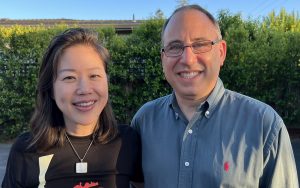Guest Blog Post: 5 Ways to Promote Scholarship and Junior Scholars in Law Schools (a post dedicated to Eric Goldman)
by guest blogger Colleen Chien
 Last week was my last one as a tenured professor at Santa Clara Law School. While I’m thrilled to be returning to my alma mater, Berkeley Law, Santa Clara has been a terrific place to grow and, in an administrative capacity, to promote scholarship and junior scholars, particularly in collaboration with people like Santa Clara Law Professor and Associate Dean of Research Eric Goldman, who uniquely combines genuine joy from promoting and uplifting others with skill and ingenuity in doing so. My visits to other Law Schools and my conversations with colleagues at other schools have also provided inspiration. Here are five practices for promoting scholarship and junior scholars:
Last week was my last one as a tenured professor at Santa Clara Law School. While I’m thrilled to be returning to my alma mater, Berkeley Law, Santa Clara has been a terrific place to grow and, in an administrative capacity, to promote scholarship and junior scholars, particularly in collaboration with people like Santa Clara Law Professor and Associate Dean of Research Eric Goldman, who uniquely combines genuine joy from promoting and uplifting others with skill and ingenuity in doing so. My visits to other Law Schools and my conversations with colleagues at other schools have also provided inspiration. Here are five practices for promoting scholarship and junior scholars:
1. Celebrate scholarship through a digital carousel or physical display.
While everyone’s digital footprint and daily online journey varies, all law teachers must enter the law building to teach their classes, meet with students, and fulfill their duties. To foster awareness of what everyone is working on, the Santa Clara Law building features electronic carousels that include recent or notable scholarship accomplishments in their regular rotation. At Columbia Law School, where I picked up this practice when I visited, they had both electronic billboards and physical billboards in the lobby where people waited for the elevator that I found effective enough that I brought the practice back to Santa Clara.
Ex: carousel display
2. Host “Titles, Abstracts, and intros” workshops before each submission cycle.
Although often getting the least amount of time, the title, abstract, and introduction can matter most, among content within a professor’s control, when it comes to law review submissions. Adapting a practice I learned about from the insightful and generous Professor David Schwartz, who served as Associate Dean of Research and Intellectual Life at Northwestern, at Santa Clara we began a practice of holding workshops dedicated to the refinement of these key article components. Documents are due the week before the workshop and those who are read also read. We used a rubric developed based on our own Law Review’s review process and also invited Law Review students and staff to also comment on the papers.
3. Institutionalize mechanisms to disseminate and promote – not just produce – scholarship.
Among a number of innovative interventions developed by Eric Goldman as Associate Dean of Research, one set has been geared towards increasing readership. Once an article is posted to SSRN, his team “emails it to the people you cite in your footnotes and other influencers.” This is a huge gift to all authors, but especially those who are more junior or for whatever reason, like most of us, do not have a disciplined approach to disseminating articles. It’s also a lot more environmentally friendly and targeted. Eric also created Santa Clara Research Dean social presences to announce the publication of new articles and scholarship milestones. As part of one’s Faculty Activity Report, faculty are now required to articulate what they will do after, and not only before, acceptance, to increase impact. As Eric has often said – if you spend 500-1000 hours on an article, surely it’s justified to spend some small fraction of that promoting it.
4. Create spaces for discussing the mechanics, not only the substance of research, placement, and promotion.
How and when to submit to the law review process. How to get editors and policymakers to read your work. How to leverage ChatGPT to carry out research. How to approach book projects. These are topics that we have discussed as a community both as part of a research focused opt-in google group and during our Faculty Enrichment Workshops when there was no speaker.
5. Get people out of their offices and talking to each other.
Given schedule differences, the halls of the ivory tower are often lonely ones, especially post-Covid. Practices centered around food vary and can be as elaborate as daily breakfasts and afternoon treats or as modest as stocking the faculty lounge with peanut butter, jam, and bread (as at USC), but seem to be universally appreciated. Encouraging faculty funds to be spent on mentoring lunches can also increase organic connections. My new institution appears to feature a weekly drop-in walking group, fostering exchange and health, that I’m excited to check out.
***
The list above provides practices for promoting scholarship and junior scholars, some of which I was fortunate enough to work with Santa Clara Law Faculty to implement. For more ideas on how to support your junior colleagues, see Eric’s generous tribute, which shows the many ways he supported me throughout my career – by nominating me for awards inside and outside the institution, acting as a sounding board, and being a champion and confidante I could turn to in good and bad moments. I’m glad I could collaborate with him on the promotion of scholarship and junior scholars – and welcome your suggestions for how to do so as well.

